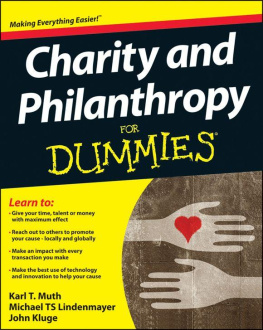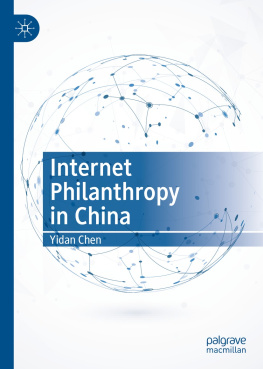
Charity & Philanthropy For Dummies
Published by: John Wiley & Sons, Ltd., The Atrium, Southern Gate, Chichester, www.wiley.com
This edition first published 2013
2014 John Wiley & Sons, Ltd, Chichester, West Sussex.
Registered office
John Wiley & Sons Ltd, The Atrium, Southern Gate, Chichester, West Sussex, PO19 8SQ, United Kingdom
For details of our global editorial offices, for customer services and for information about how to apply for permission to reuse the copyright material in this book please see our website at www.wiley.com .
The right of the author to be identified as the author of this work has been asserted in accordance with the Copyright, Designs and Patents Act 1988.
All rights reserved. No part of this publication may be reproduced, stored in a retrieval system, or transmitted, in any form or by any means, electronic, mechanical, photocopying, recording or otherwise, except as permitted by the UK Copyright, Designs and Patents Act 1988, without the prior permission of the publisher.
Wiley publishes in a variety of print and electronic formats and by print-on-demand. Some material included with standard print versions of this book may not be included in e-books or in print-on-demand. If this book refers to media such as a CD or DVD that is not included in the version you purchased, you may download this material at http://booksupport.wiley.com . For more information about Wiley products, visit www.wiley.com .
Designations used by companies to distinguish their products are often claimed as trademarks. All brand names and product names used in this book are trade names, service marks, trademarks or registered trademarks of their respective owners. The publisher is not associated with any product or vendor mentioned in this book.
LIMIT OF LIABILITY/DISCLAIMER OF WARRANTY: WHILE THE PUBLISHER AND AUTHOR HAVE USED THEIR BEST EFFORTS IN PREPARING THIS BOOK, THEY MAKE NO REPRESENTATIONS OR WARRANTIES WITH THE RESPECT TO THE ACCURACY OR COMPLETENESS OF THE CONTENTS OF THIS BOOK AND SPECIFICALLY DISCLAIM ANY IMPLIED WARRANTIES OF MERCHANTABILITY OR FITNESS FOR A PARTICULAR PURPOSE. IT IS SOLD ON THE UNDERSTANDING THAT THE PUBLISHER IS NOT ENGAGED IN RENDERING PROFESSIONAL SERVICES AND NEITHER THE PUBLISHER NOR THE AUTHOR SHALL BE LIABLE FOR DAMAGES ARISING HEREFROM. IF PROFESSIONAL ADVICE OR OTHER EXPERT ASSISTANCE IS REQUIRED, THE SERVICES OF A COMPETENT PROFESSIONAL SHOULD BE SOUGHT.
For general information on our other products and services, please contact our Customer Care Department within the U.S. at 877-762-2974, outside the U.S. at (001) 317-572-3993, or fax 317-572-4002.
For technical support, please visit www.wiley.com/techsupport .
A catalogue record for this book is available from the British Library.
ISBN 978-1-119-94187-3 (pbk), ISBN 978-1-119-94394-5 (ebk), 978-1-119-94393-8 (ebk), ISBN 978-1-119-94395-2 (ebk)
Printed and bound in the United States of America by Bind-Rite
10 9 8 7 6 5 4 3 2 1

Charity & Philanthropy For Dummies
Visit www.dummies.com/cheatsheet/charityandphilanthropy to view this book's cheat sheet.
- Table of Contents
Foreword
The Difference.
Giving is what makes humans different. When homo sapiens crossed the mouth of the Red Sea 50, 000 years ago, we had learned how to cooperate in groups of up to 100, at most 150 people. Now America has over 300 million citezens, and India and China each has over 1 billion. Further, you and all of us, participate every day in the world-wide web, and organisations of all sorts in every sector buy and sell and serve globally.
The acceleration in people helping one another one on one and globally and in all sorts of combinations in between is the central historical force at work. This irresistible force is, moreover, now accelerating exponentially.
That is why this book is so important.
If there is one area in which we must now all excel, it is knowing how to give, how to make a difference for the good.
The highest level of giving is to help others give.
Nothing can bring better health or deeper happiness than enabling another person or group to give especially if you help them give at a significant level of impact.
Both the great religious prophets and todays science agree on how centrally important it is to express love and respect in action at the highest possible level.
When you help others thus meet their highest potential as social beings, of course, you are at the same time helping society far more powerfully than you could in almost any other way.
That is true when you help a child become a loving, confident person who can and will bring change for the good whenever needed. It is true when you help a citizen group remove barriers that prevent others (be they women or new immigrants) from living and giving fully. It is certainly true when you find and back a society-wide pattern change social entrepreneur through the long years such deep change usually requires. (If theres a need, the first on the scene are these far-seeing system-change entrepreneurs. Two Ashoka examples: (a) increasing rural school enrollments 44 percent and cutting dropout rates in half in Bangladesh largely by engaging students in teaching and in running profitable businesses; and (b) cutting rural electrification costs in Brazil 70-90 percent.)
For each need there are many avenues for giving. In this book Karl Muth, Michael Lindenmayer and John Kluge gives you an extraordinarily comprehensive map of your options and a wide range of excellently chosen examples in every field.
Given societys manifold needs, and given the greater satisfaction that comes from achieving greater impact, it is key to know how to contribute in the most significant way.
Today that means changemaking.
The rate of change has been escalating exponentially for at least three centuries. That is a mathematical fact.
The same is true for the number of people causing change.
It is also true (and I believe this is especially important) for the number of combinations, and combinations of combinations changemakers collaborating together,
As a result of these dramatically accelerating historical forces, society is now hurtling towards the most fundamental restructuring of how we work together ever. We are well into the tipping process.
Throughout history and pre-history society has been organised to achieve efficiency through repetition. Think the law firm or the assembly line. Think our traditional definition of educational success mastering a body of knowledge and an associated set of rules so that one can go forth and be a baker or banker for life.
Theres always been some change, at least evolutionary change. (The human skull became thinner and thinner over the last 50, 000 years as we developed better social skills.) But we organised chiefly to achieve efficiency in repetition.
The world is failing fast.
In a world defined by the opposite of repetition, change, we must shift to an opposite way of educating and organising.
Success in growing up now must start with ensuring that every young person has mastered the social skills to be a contributing changemaker in an everyone a changemaker world and has practised and practised so that he or she confidently is a changemaker before 21. These core skills are empathy, teamwork, the new leadership (leading teams of teams where everyone is a changemaker), and changmaking.
In a world of escalating change, the rules cover less and less. Anyone who tries to be a good person by diligently following the rules will, as the inevitable if unintended result, hurt people and disrupt groups. They (and quite likely their group with them) will be marginalized, i.e., thrown out. That is one of the reasons why the skill of empathy is such a foundational essential now.








